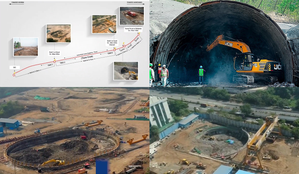Mumbai: The works on the Mumbai-Ahmedabad Bullet Train project’s terminus at Bandra Kurla Complex and a key 21-km underground-undersea tunnel work, wrought with challenges, are progressing satisfactorily, National High Speed Rail Corporation Ltd., an official said here on Thursday.
The 21-km long single-tunnel, including 7 km running under-sea, with two lines is coming up between Bandra Kurla Complex and Shilphata in Thane.
Work is currently on for three shafts en route for the tunnel section at Bandra Kurla Complex, Vikhroli, Sawli, Shilphata and an Additional Driven Intermediate Tunnel portal.
The shaft 1 is coming up at the Mumbai High Speed Railway Station in Bandra at a depth of 36 metres where 100 per cent secant piling work is completed and excavation work is underway. The shaft 2 at Vikhroli is at a similar depth of 36 metres, with 100 per cent piling work done and excavation work is on.
These shafts shall be used to lower two tunnel boring machines (TBMs) in opposite directions – one which will bore towards the BKC and the other towards Ghansoli.
The 39 metres deep shaft 3 in Sawli (near Ghansoli) excavation work is on, while at Shilphata, the tunnel end, portal work has begun at the site.
The tunnel will be dug by three TBMs with a cutter head diameter of 13.6 metres — usually 5-6 meter diameter cutter heads are deployed for digging urban tunnels as in the Mumbai Metro systems.
Three TBMs will be used to make around 16 kms of the tunnel, while the remaining 5 km shall be dug through New Austrian Tunnelling Method (NATM).
The tunnel will be around 25-27 metres deep from the ground level, with the deepest point at 114 metres below the Parsik Hill near Shilphata.
The three shafts of BKC, Vikhroli and Sawli shall be at depths of 36, 56 and 39 metres, the inclined shaft of 42 metres at Ghansoli and at Shilphata will facilitate the construction of a 5 km tunnel through the NATM method.
Besides, the Additional Drive Intermediate Tunnel (ADIT) portal is also coming up which will facilitate an additional access to the tunnel for faster construction activity.
The NHSRCL engineers are grappling with multiple challenges to speed up and make the showpiece — Prime Minister Narendra Modi’s dream project, work on which started in September 2017 — into a reality.
The work entails controlled multiple blasting with sufficient noise-air pollution control measures to cause minimal disturbances to the environment and population in the adjoining areas.
The shafts are being dug in areas with high population density and adjoining utilities like various pipelines, electrical installations, other neighbouring infrastructure projects like metros, highways, flyovers, etc.
“We are ensuring that the work is carried out with least disruption to these. The disposal of the huge quantities of excavated materials is done with the supervision of Maharashtra Pollution Control Board, with each trip approved and GPS tracked,” said an official. Other facilities like Gantry Cranes, labour force colonies, site offices and other requirements are also being built in tandem with the bullet train.
The single-tube tunnel has 39 equipment rooms at 37 spots shall be constructed adjoining the tunnel location.
Around 4.8 hectares of land for the Bullet Train terminus at BKC Station has been handed over by NHSRCL to the contractors to build the station with the ‘bottom-up method’.
This implies that the excavation work of at least 32 metres depth will commence from the ground level and concrete work will be taken up from the foundation.
The deep excavation involves around 18 lakh cubic metres for which a suitable ground support system has to be constructed to prevent the soil from collapsing.
This involves constructing 3,382 secant piles, each ranging from 17 to 21 metres in depth, all of which are in place and the excavation in the station area has begun, and around 1.5 lakh cubic metres of the earth is already removed and disposed off.
Currently, teams of around 681 workers and supervisors are toiling at the project sites round the clock, and as the project advances, it may touch upto 6,000 people daily during peak times.
(Quaid Najmi can be contacted at: q.najmi@ians.in)
–IANS


Comments are closed.